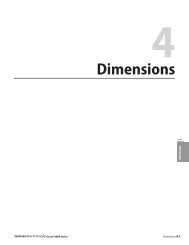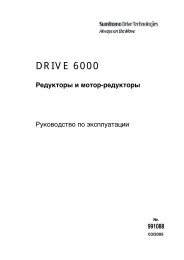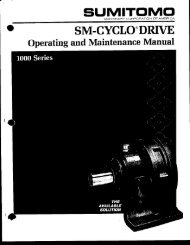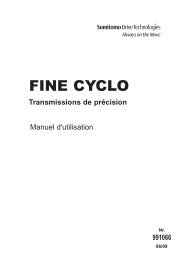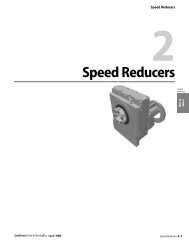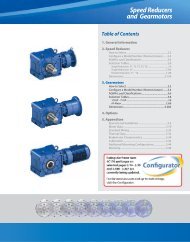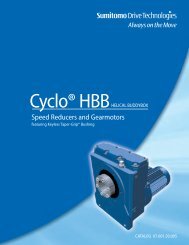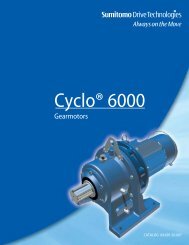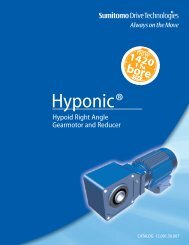Cyclo® 6000 - Sumitomo Drive Technologies
Cyclo® 6000 - Sumitomo Drive Technologies
Cyclo® 6000 - Sumitomo Drive Technologies
Create successful ePaper yourself
Turn your PDF publications into a flip-book with our unique Google optimized e-Paper software.
How do I select a <strong>Cyclo®</strong> speed reducer or gearmotor?<br />
Selection is based on the actual horsepower and/or torque requirements at the output<br />
shaft. The <strong>Cyclo®</strong> speed reducer has particularly high efficiencies over a wide range of<br />
reduction ratios, which frequently permits the use of reduced input power requirements<br />
(smaller HP motor) without sacrificing output shaft torque. The selection procedures in this<br />
catalog will guide you in choosing the most efficient reducer for your application.<br />
What information do I need to get started in the selection process?<br />
To select the proper reducer for your application, you will need to know:<br />
• Application: type of driven machine<br />
• Hours of operation per day<br />
• Motor horsepower (HP) and speed (RPM)<br />
• Mounting position<br />
If there are any special environmental factors or operation requirements, they must also be<br />
noted. This information will be important in determining the Service Factor of your<br />
application.<br />
What are Service Factors and how are they used?<br />
In general, reducers and gearmotors are rated for the specific conditions and operating<br />
requirements of the application by the use of AGMA-defined Service Factors. There are<br />
three AGMA load classifications for reducers: uniform (U), moderate shock (M) and heavy<br />
shock (H) (page 2.3) The Service Factors are used in the product selection process to adjust<br />
for the specific conditions and operating requirements of your application.<br />
What do I do if my application has particularly severe operating conditions?<br />
The standard ratings for <strong>Cyclo®</strong> are based on 10-hour daily service under conditions of uniform<br />
loads (equivalent to AGMA service factor 1.0). By following the product selection<br />
process, you will determine and apply the Service Factors to compensate for the severe<br />
operating conditions.<br />
How can I be sure that the reducer can withstand periodic excessive overloads?<br />
<strong>Cyclo®</strong> Speed Reducers provide 500% momentary intermittent shock load capacity. For<br />
applications with shock loads greater than 500%, consult an SMA Application Engineer.<br />
What are the standard input speeds?<br />
In general terms, the speeds are 1750 and 1165 RPM. The selection tables in this catalog are<br />
based on 1750, 1165, 870, 580, and 50 RPM. When non-standard input speeds are used, the<br />
horsepower and torque ratings also vary.<br />
What thermal capacity limitations does the <strong>Cyclo®</strong> have?<br />
The <strong>Cyclo®</strong> speed reducer, by virtue of its smooth, almost frictionless operation (unlike traditional<br />
helical gears), has a thermal rating that far exceeds its mechanical capacity and all but<br />
eliminates the conventional limitations due to heat.<br />
<strong>Cyclo®</strong> <strong>6000</strong> Series<br />
CYCLO® <strong>6000</strong> Speed Reducers<br />
FAQs<br />
Common Configurations<br />
Single Reduction,<br />
Horizontal Flange Mount<br />
with Hollow Shaft Input<br />
Single Reduction, Flange<br />
Mount with C-Face Adapter<br />
Single Reduction, V-Flange Mount<br />
with C-Face Adapter<br />
Double Reduction with<br />
C-Face Adapter<br />
General Information 1.5



